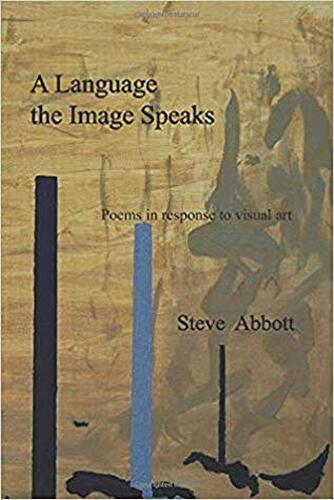|
A Language the Image Speaks: Poems in Response to Visual Art by Steve Abbott This is one of the best books of poetry I’ve read this year because the poems—excellent, solid, many positively brilliant—are all wonderful and that’s just the start of it. Well, start and end of it. In between, Abbott has achieved what online journals, such as The Ekphrastic Review, but very few print anthologies have achieved, which is to say, a book of ekphrastic poems accompanied by gorgeous, vivid, full-page copies of the related artworks, mostly paintings in this book, also photographs and sculptures. Before I discuss what a tour de force the book is as a whole, I want to say a word about the words, which Abbott has been smithing a long time. He is a terrific poet with six previous poetry collections, as well as of poems in many journals, including two poems published in this review. (You can do so here: “Albino Sword Swallower at a Carnival” and “Morning Sun.”) His poems in this volume are varied in subject, shape on the page, sound play, tone, and syntax, that latter ranging from the fragmentary of his haiku: The forest clearing morning fog-- my golden blanket (from "Four Haiku" after Something Happened, a painting by Jo Dickinson) to sentences that pull the reader along to reach their end: …This expanse is a canvas of long shadows spare minutes of sun unroll across a cold world. (from “Blue Light” after The Battery, a painting by George Bellows) The poems range from the humorous: “The drummer’s parents weren’t quite serious/when they complained my bass guitar was loosening/copper fittings in the pipes….” (“Triphammer”) to this satiric commentary on Father Coughlin: The answer, of course, is simple: They are not like us, Our Heritage And faith and flag. Not like Us, who understand the real danger the loss of rightful place, above Them with their odd odors and leather skins, over there…. (“At the Leading Candidate’s Rally”) And there is sweet personal tenderness, as in these closing lines based on a photograph: These edges that blend line and light, obscuring where the borders are and what it is that crosses them now, and in the night, in my heart, silently, like a cloud. (“Lost Cloud”) While the poems tend to free verse, they exhibit a great variety of form, from regular two and three line stanzas to solid singular blocks to fragments splayed margin to margin so that, in a way, the poems are as pictographic as the works on their facing pages and skillfully full of sound play: Against the wall, out of the wind, a broken crate makes a table. Simple, stable, like the men holding the cards, the men who move only when the cards move. (from “Frenchmen Playing Cards”) Certainly a good ekphrastic poem can stand alone without illustration from its impetus, but I love it when the art accompanies the poem, and it is difficult, expensive, and time-consuming to obtain rights, and find the right printer for the job. The few ekphrastic print collections I’ve seen have been anthologies and often of contemporary art only, or art old enough to be in the public domain. However, the the art in Abbott’s collection is as wide ranging as his writing style, from the classical mid-18th century painting by Jean-Marc Nattier, to modern classics by Louise Nevelson, Edward Hopper, Elijah Pierce, and George Bellows, to contemporary works by living artists around the U.S. and the world, including Abbott’s hometown of Columbus, Ohio. The subject matter of the art and poems ranges from the political (a painting on the French Revolution as well as a photograph of white nationalists in 2017) to the descriptive of nature, architecture, scenes, people, and music, to the contemporary design of a puzzle box lid (“Jigsaw”) and a playing card (“Queen of Spades”). The last ten pages of the book exhibit the yeoman’s work that Abbott put into the collection beyond writing the poems, including his notes on the paintings and bios on the artists. It also lists agencies and individuals who helped with the permissions and with the financial costs of such a book, an example of patronage in the best sense of the word. As I read the book, I thought of Simonides’ words: “Poetry is painting with the gift of speech,” because in these poems, painting and related arts have definitely found the supreme speaker and maker in Steve Abbott’s A Language the Image Speaks. Diane Kendig Diane Kendig’s most recent poetry collection is Prison Terms, and she co-edited the anthology, In the Company of Russell Atkins. Her poetry and prose has appeared in journals such as J Journal, Under the Sun, and Blueline, and she curates, “Read + Write: 30 Days of Poetry,” now in its sixth year with over 2200 subscribers. A Language the Image Speaks: Poems in Response to Visual Art by Steve Abbott 11th Hour Press, 2019 Click here to view or purchase at Amazon.
1 Comment
John Stickney
1/31/2020 10:04:17 am
Wonderful review, the collection sounds terrific.
Reply
Your comment will be posted after it is approved.
Leave a Reply. |
The Ekphrastic Review
COOKIES/PRIVACY
This site uses cookies to deliver your best navigation experience this time and next. Continuing here means you consent to cookies. Thank you. Join us on Facebook:
July 2024
|




